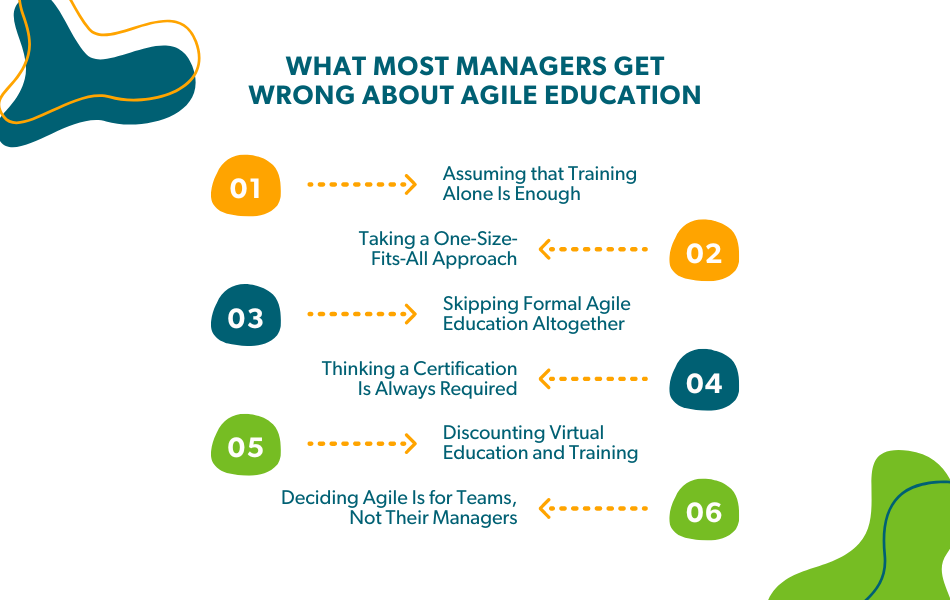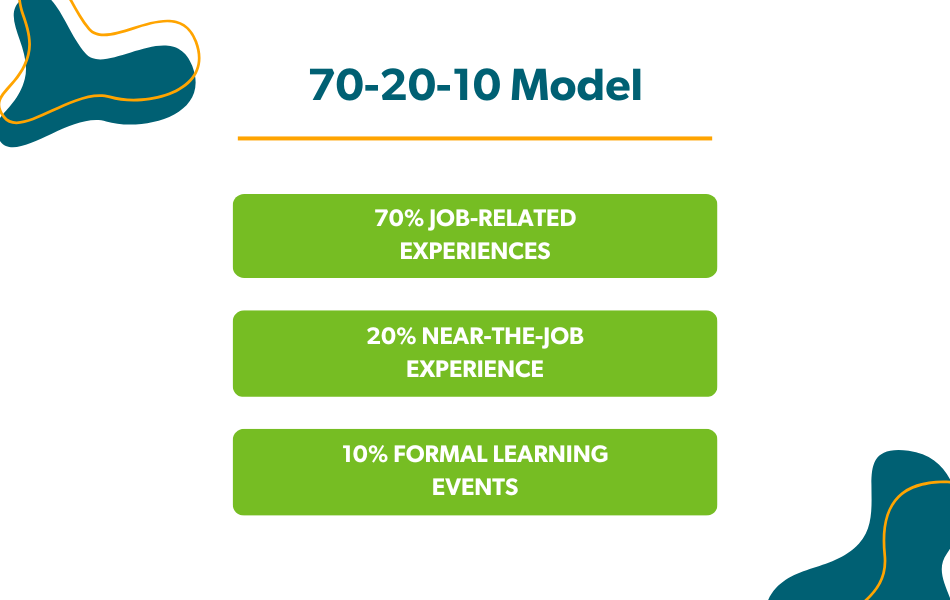Agile education is an essential foundation for Agile marketing success. However, to make that training effective, it needs to be combined with practical application of learnings, adapted to the needs of a specific marketing team, and regularly updated. This enables Agile education in marketing to drive substantial benefits for teams by equipping them to deal with new technologies like AI.
Any Agile marketing transition is going to involve some level of Agile education. Knowledge of Agile principles, ways of thinking, and practices are all foundational for success. In our years of experience providing Agile education in marketing, we’ve seen (and made) every mistake you can imagine. Fortunately, Agile is all about experimenting, making mistakes, and applying those learnings.
So in that spirit, we’re sharing a list of the biggest mistakes and misconceptions we’ve seen managers fall prey to when approaching Agile education in marketing. Avoiding these mistakes will help you:
- Supercharging your transformation
- Get more out of Agile
- Avoid the frustration and high cost of “fake Agile.”

1. Assuming that Training Alone Is Enough
In any Agile transformation, whether for a single team or an entire organization, there will inevitably be unique challenges to work through. That’s why it’s so important to not just provide Agile marketing training to your team and assume they can operate in an Agile environment. Effective Agile education in marketing requires implementing that training as well.
To understand what complete Agile education looks like, we can look to the 70-20-10 model for new learning development. The idea behind this model is to ensure that new learning is actually developed into knowledge and practice. It shouldn’t be read as prescriptive, but rather as guidelines designed to remind you to balance the way team members learn and develop their Agile skills.

It breaks down work and performance learning into three groups, specifying that those acquiring new skills are best positioned for success if they get a recipe of:
- 70% of their knowledge from on-the-ground job-related experiences
- 20% from working with others, like coworkers and managers
- 10% from actual formal learning events
In other words, people learn mostly from actual experiences. Classroom training should be designed to supplement those experiences, rather than becoming the main focus of education. If you think back to your high school years, chances are you can remember something like how to perform a physical task you learned in a job better than something abstract you only studied in a classroom.
That means, for all its importance (and it is very important), Agile training should make up just 10% of the time devoted to learning Agile education in marketing. So ensure your team members have plenty of time dedicated to experiences and collaboration to supplement formal learning.
2. Taking a One-Size-Fits-All Approach
Everyone learns differently and, depending on who you ask, there are anywhere from four to 8+ different learning styles. But the main four most relevant for Agile education are:
- Visual; In this style, tools like charts can help to show the organizational structure and how Agile processes work.
- Auditory; Instead of only reading about Agile principles, some learners may prefer to discuss and hear about them instead.
- Kinesthetic; This refers to learning by actually doing. This style comes into play when actually implementing and honing Agile practices.
- Reading/writing; Some learners may do better when given time to read and reflect on Agile.
Choosing the right learning style that your teams respond to has an enormous impact on the quality of learning overall as well as retention. So it’s no surprise that taking a one-size-fits-all approach to Agile education substantially decreases its impact. But in most cases, it’s enough to simply ensure the Agile education your team members are getting uses all four of these styles.
3. Skipping Formal Agile Education in Marketing Altogether
Perhaps you’ve heard that applying Agile in real-world circumstances always requires adaptation. While that’s true, it doesn’t mean you should skip formal Agile education in favor of more on-the-job learning. The reality is that both are required for success.
Formal Agile education is what gives your individual team members and the team as a whole a shared foundation in the core principles and practices they’ll need. The kind of ongoing learning and adaptation of Agile that’s so important for success is far easier and more effective if it's built on this kind of foundation.
Otherwise, transformations risk stalling, as people get frustrated that they’re not getting the Agile benefits they were promised as they struggle to learn and adapt in real time. Agile transformations that take too long can lead to a long list of other problems like key talent quitting, teams getting demotivated, and feelings of isolation as Agile progresses at different speeds through different functions.
4. Thinking a Certification Is Always Required
Don’t get us wrong, Agile certifications can be tremendously helpful. Agile Project Management certifications, for example, can improve career prospects and help practitioners be more effective. The problem comes in assuming that managing an Agile team or participating in one always requires certification.
The fact is that many certifications are unnecessarily expensive and time-consuming for many learners. Considering the resources involved in making an Agile transformation, you can’t afford to waste them on something that’s not going to make a difference in the grand scheme of your team’s success. So you need to be deliberate about whether certification is actually going to help you be a better Agile leader and whether your team members need it to leverage Agile ways of working fully.
All that said, if you or one of your team members do want to get an Agile certification, be sure to choose one designed for someone with your background and experience. Otherwise, you risk wasting time and money on something that’s not going to substantially help you.
5. Discounting Virtual Education and Training
In-person Agile training is great, we’ve done it for years and seen the impact it can have. However, if that option isn’t practical because you have a distributed team then the answer is definitely not to skip Agile education in marketing altogether. Fortunately for teams based far from potential Agile educators, virtual education has come a long way and can equal the effectiveness of virtual training.
However, even if in-person training is an option, a combination of virtual learning for formal training and in-person workshops to practice those learnings can actually be a winning strategy. It’s essentially another way to implement the 70-20-10 system mentioned above, combining limited in-person training with virtual follow-ups to help learners further hone their skills and apply their learnings.
There are also plenty of asynchronous options for Agile education in marketing. Instead of learning in a cohort, such smaller Agile learning courses offer a way to learn on your own schedule and at your own pace.
6. Deciding Agile Is for Teams, Not Their Managers
Unfortunately, providing Agile education in marketing for teams and not their managers is a recipe for creating a strong disconnect between the two. Managers and team members need to work together to find the best ways to apply Agile principles to their challenges. When only one or the other has a foundation in those principles, this kind of collaboration becomes extremely difficult.
This is also important because Agile organizations thrive when they are less hierarchical, as this enables greater flexibility, accountability, and empowers people to take initiative and ownership of their work. Training managers and team members alike help reinforce this flatter structure, reinforcing the idea that everyone is going through this Agile transformation together.
7. Assuming Agile Education in Marketing Is Ever “Finished”
Agile is built around continuous improvement. That applies just as much to individual marketers as it does to the processes they use every day. To be effective in the long-term, Agile education in marketing needs to be something that never fully stops.
New technologies, tools, and channels are always coming up. Agile is built around adapting to these changes, but in that process teams often drift away from Agile principles. The result is teams that think they’re working in an Agile way when in fact they’re making crucial mistakes that are robbing them of its benefits. This phenomenon is also known as fake Agile and it’s tremendously costly.
Being consistent about your Agile education helps keep you and your teams fresh and effective.
8. Ignoring the Importance of Agile Education for AI Success
Marketers everywhere know that successfully integrating AI into their work is critical for long-term success. However, many struggle to figure out just how to integrate this technology into their processes. Compliance challenges, ethics considerations, and simple practical questions about what AI can and can’t do have many marketing functions feeling paralyzed.
Agile marketing is ideally suited to tackle all of these problems. Because experimentation, adaptation, and continuous improvement are all built-in, Agile provides a ready-made way to effectively bring AI into your marketing.
Instead of viewing that integration as an anomaly, it’s simply another optimization to test and play around with. The mindset you’ve cultivated through Agile education in marketing is ready to play with AI until you find a way to effectively use it.
Agile Education in Marketing FAQs
What is the Agile approach in marketing?
In short, the Agile approach in marketing is built around breaking work down into smaller pieces. This enables teams to test, iterate, and gather feedback more regularly. The result is marketing that’s more adaptive, responsive, and aligned around the needs of its stakeholders and customers.
What is the Agile method of education?
While there isn’t a formal “Agile method of education,” Agile itself is built around continuous improvement. Educating yourself in an Agile way entails testing, iterating, experimenting, and applying new learnings on a regular basis. For example, by embracing microlearning instead of larger more structured courses. It may also mean working more with coaches and practitioners to apply knowledge in creative ways.
What is an example of Agile marketing?
A classic example of Agile marketing is contrasting a “big bang” or “waterfall” campaign with an Agile one. A big bang campaign sees marketers working for months before the campaign is let out into the world. Only then do the marketers learn how it performs. Agile marketing breaks those big campaigns into smaller pieces that can be tested quickly and cheaply. Those learnings are then integrated into the next set of campaigns, enabling rapid improvement and adaptation.
What are Agile marketing principles?
The ten Agile marketing principles are:
- Great marketing requires close alignment, transparency, and quality interactions with internal and external customers.
- Seek out different and diverse points of view.
- Embrace and respond to change to enhance customer value.
- Plan only to a level sufficient to ensure effective prioritization and execution.
- Take chances, and learn from your failures.
- Organize in small, cross-functional teams where possible.
- Build marketing programs around motivated individuals and trust them to get the job done.
- Long-term marketing success benefits from operating at a sustainable pace.
- Agile marketing isn’t enough. Excellence in marketing requires continuous attention to marketing fundamentals as well.
- Strive for simplicity.
Ready to Begin Your Agile Education?
Now that you have an understanding of what Agile education should look like (and what to avoid), you’re ready to move ahead. A great place to start is learning the fundamentals of business agility.
This will give you the broader context to understand how Agile can work across functions like HR, Finance, and more, enabling you to be a more effective manager in a broader Agile business environment.